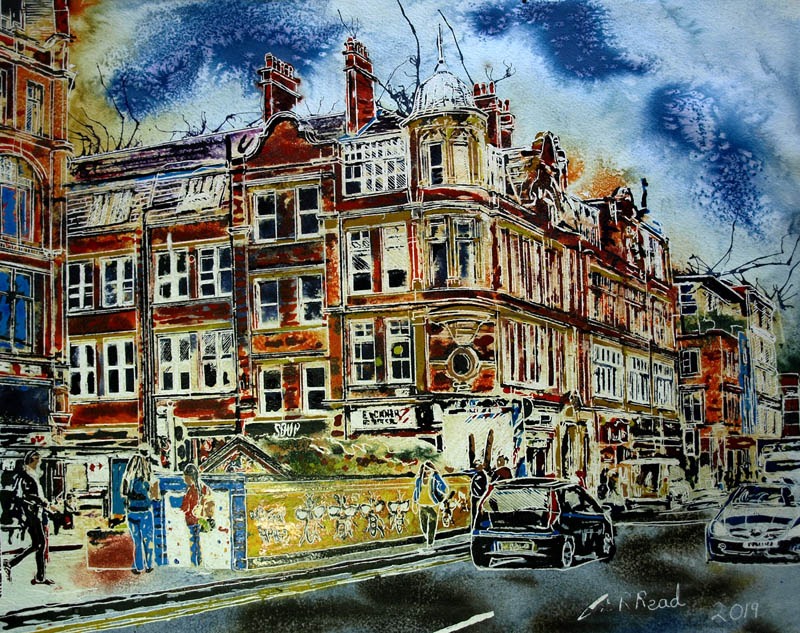STEVENSON SQUARE BEES
Stevenson Square Bees. The humble worker bee is a famous Manchester symbol and city emblem spanning over 150 years. In the 18th and 19th Centuries, Manchester was at the Industrial Revolution’s very heart – colloquially known as “Cottonopolis” because of the vast cotton fabric production.
The Mancunian factories were sometimes referred to as beehives, referring to the busy and productive workers who drove progress onward. A century later, the bee still accurately denotes Mancunians’ hard work ethic and the city’s bustling activity. It has also come to represent the sense of unity in the great city – through joyous and wretched times.
A not so ordinary day
This Cathy Read painting of Stevenson Square depicts an apparently ordinary day. But in fact, at the time, a highly charged atmosphere prevailed. The reference image was taken less than a fortnight after a dreadful event and alertness and introspection were evident in the air. An atmosphere which intensified with every block the closer one moved toward the city centre and the St Ann’s Square memorial.
What tragedy had altered the noble city?
22 May 2017. Innocent and unsuspecting people, attending an Ariana Grande concert in Manchester, became the target of a terrible attack sadly injuring and killing several victims.
The intention was to spur on molten hatred, but Mancunian’s would have none of it!
Instead of cowering in fear, Manchester city united under the symbol of a bee. The city galvanised its association with the event and Mancunian’s everywhere proudly wore the symbol. At the time, several murals depicting a bee sprang up all over Manchester. Art served as a solace – a memorial to the victims and a reflection of Manchester’s emotions.
Stevenson Square Bee Mural
The Stevenson Square Bee mural in the painting appeared soon after the event. The brilliant yellow background glows on the dullest of days spreading indefatigable hope. People wander past determined to keep the everyday normality intact – some stop to appreciate the new artwork, others oblivious, intent on their journey to work, shopping or returning home.
The surrounding architecture of Stevenson Square is typical of this area of Manchester. Opposite are two shops that supply the city’s art lovers with canvases and brushes: nearby Fred Aldous and H.S Blythe and Co. Sadly, the latter has now closed, ending over 100 years of service. H.Blyth & Co, established in 1889, supplied Victorian Manchester’s thriving engineering industry with drawing equipment t.
The painting is a hive of activity. Stunning orange and red brick- and stonework provides a magnificent backdrop to ordinary life. Traffic roars past and a van is unloading. On the right-hand side, the lanky man in black saunters into view. Girls chatter beside The Bees and figures stroll past.
Do those bees also keep drawing back your attention?
It is challenging not to focus on the events that reignited the Manchester symbol. But choose the better part. Rather see the dignified, resilient, and defiant reaction in the aftermath of violence.
4 June 2017. In response to the bombing, a benefit concert and British television special – ‘One Love Manchester’ -were was organised.
The painting’s scene captures the day before the One Love concert in Old Trafford – a fitting reminder to kick back despite acts of terrorism. However hard it may be, if we change our actions out of fear, we let them win. And Manchester wasn’t going to let the thugs win.
Stevenson Square Bees. An emblem of a city built on hard work and resilience. “We might get knocked down, but Manchester gets right back up again!”

See more of the delights Manchester has to offer,

Always love seeing your work and it’s great to read the story behind it. Congratulations on the website – no small feat!
Thanks Beth! Yes, it’s a challenging action but very satisfying once it’s been done.